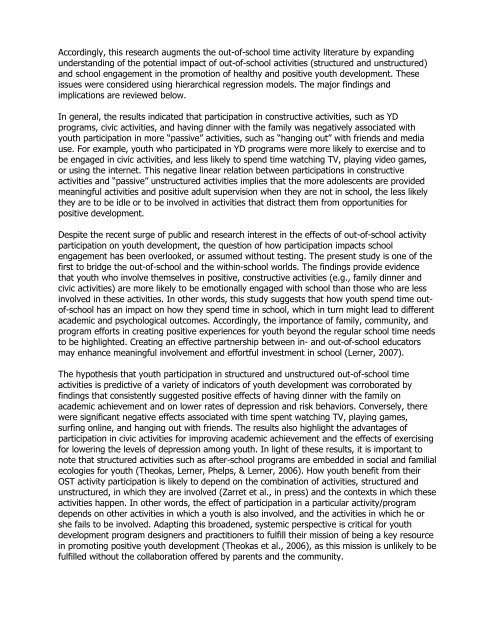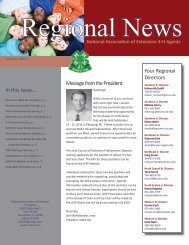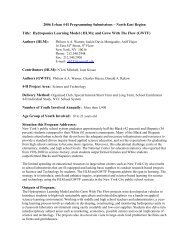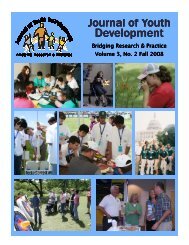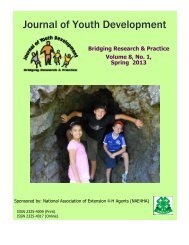Winter 2008 - Vol. 3 No. 3 - National Association of Extension 4-H ...
Winter 2008 - Vol. 3 No. 3 - National Association of Extension 4-H ...
Winter 2008 - Vol. 3 No. 3 - National Association of Extension 4-H ...
- No tags were found...
You also want an ePaper? Increase the reach of your titles
YUMPU automatically turns print PDFs into web optimized ePapers that Google loves.
Accordingly, this research augments the out-<strong>of</strong>-school time activity literature by expandingunderstanding <strong>of</strong> the potential impact <strong>of</strong> out-<strong>of</strong>-school activities (structured and unstructured)and school engagement in the promotion <strong>of</strong> healthy and positive youth development. Theseissues were considered using hierarchical regression models. The major findings andimplications are reviewed below.In general, the results indicated that participation in constructive activities, such as YDprograms, civic activities, and having dinner with the family was negatively associated withyouth participation in more “passive” activities, such as “hanging out” with friends and mediause. For example, youth who participated in YD programs were more likely to exercise and tobe engaged in civic activities, and less likely to spend time watching TV, playing video games,or using the internet. This negative linear relation between participations in constructiveactivities and “passive” unstructured activities implies that the more adolescents are providedmeaningful activities and positive adult supervision when they are not in school, the less likelythey are to be idle or to be involved in activities that distract them from opportunities forpositive development.Despite the recent surge <strong>of</strong> public and research interest in the effects <strong>of</strong> out-<strong>of</strong>-school activityparticipation on youth development, the question <strong>of</strong> how participation impacts schoolengagement has been overlooked, or assumed without testing. The present study is one <strong>of</strong> thefirst to bridge the out-<strong>of</strong>-school and the within-school worlds. The findings provide evidencethat youth who involve themselves in positive, constructive activities (e.g., family dinner andcivic activities) are more likely to be emotionally engaged with school than those who are lessinvolved in these activities. In other words, this study suggests that how youth spend time out<strong>of</strong>-schoolhas an impact on how they spend time in school, which in turn might lead to differentacademic and psychological outcomes. Accordingly, the importance <strong>of</strong> family, community, andprogram efforts in creating positive experiences for youth beyond the regular school time needsto be highlighted. Creating an effective partnership between in- and out-<strong>of</strong>-school educatorsmay enhance meaningful involvement and effortful investment in school (Lerner, 2007).The hypothesis that youth participation in structured and unstructured out-<strong>of</strong>-school timeactivities is predictive <strong>of</strong> a variety <strong>of</strong> indicators <strong>of</strong> youth development was corroborated byfindings that consistently suggested positive effects <strong>of</strong> having dinner with the family onacademic achievement and on lower rates <strong>of</strong> depression and risk behaviors. Conversely, therewere significant negative effects associated with time spent watching TV, playing games,surfing online, and hanging out with friends. The results also highlight the advantages <strong>of</strong>participation in civic activities for improving academic achievement and the effects <strong>of</strong> exercisingfor lowering the levels <strong>of</strong> depression among youth. In light <strong>of</strong> these results, it is important tonote that structured activities such as after-school programs are embedded in social and familialecologies for youth (Theokas, Lerner, Phelps, & Lerner, 2006). How youth benefit from theirOST activity participation is likely to depend on the combination <strong>of</strong> activities, structured andunstructured, in which they are involved (Zarret et al., in press) and the contexts in which theseactivities happen. In other words, the effect <strong>of</strong> participation in a particular activity/programdepends on other activities in which a youth is also involved, and the activities in which he orshe fails to be involved. Adapting this broadened, systemic perspective is critical for youthdevelopment program designers and practitioners to fulfill their mission <strong>of</strong> being a key resourcein promoting positive youth development (Theokas et al., 2006), as this mission is unlikely to befulfilled without the collaboration <strong>of</strong>fered by parents and the community.


